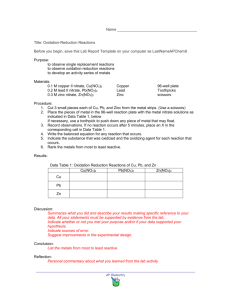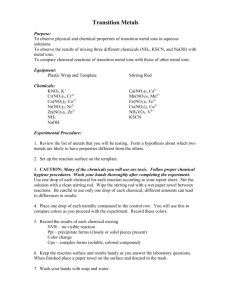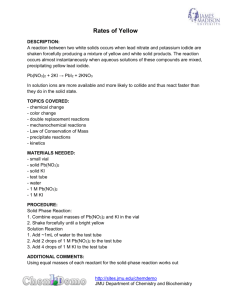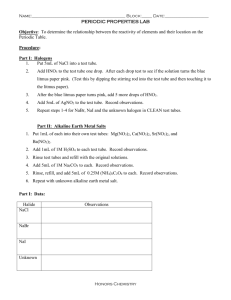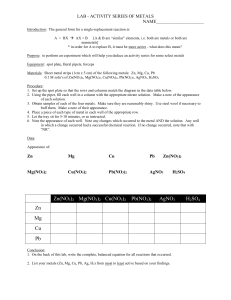Mechanical Waves ANSWERS TO QUESTIONS CHAPTER OUTLINE
advertisement
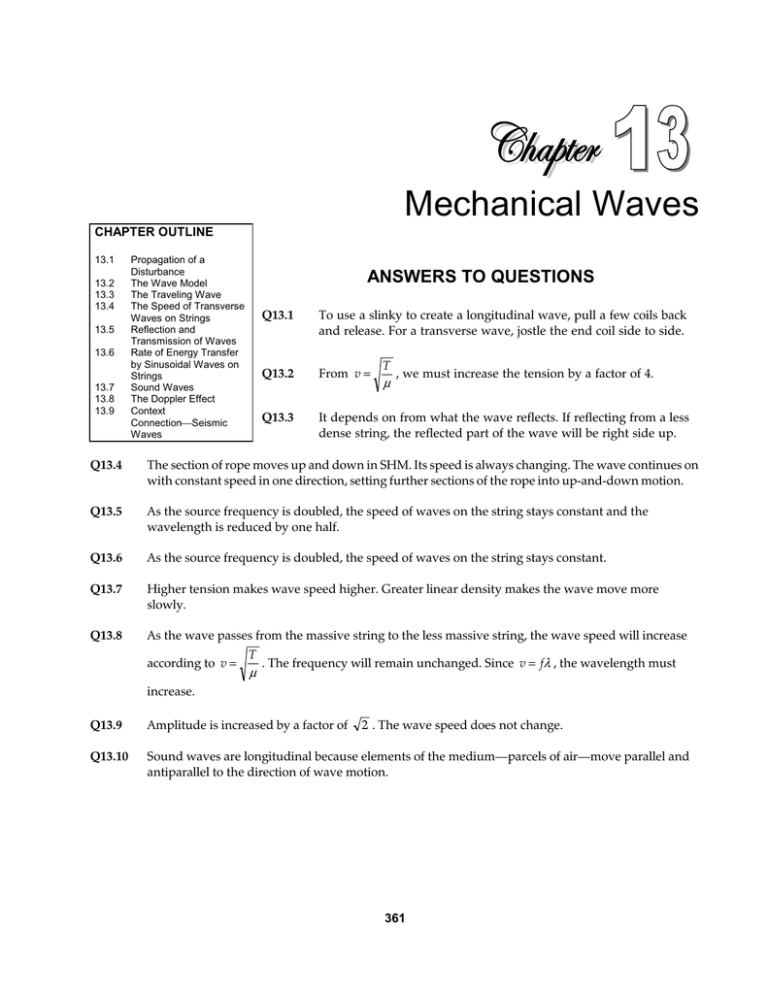
Mechanical Waves CHAPTER OUTLINE 13.1 13.2 13.3 13.4 13.5 13.6 13.7 13.8 13.9 Propagation of a Disturbance The Wave Model The Traveling Wave The Speed of Transverse Waves on Strings Reflection and Transmission of Waves Rate of Energy Transfer by Sinusoidal Waves on Strings Sound Waves The Doppler Effect Context ConnectionSeismic Waves ANSWERS TO QUESTIONS Q13.1 To use a slinky to create a longitudinal wave, pull a few coils back and release. For a transverse wave, jostle the end coil side to side. Q13.2 From v = Q13.3 It depends on from what the wave reflects. If reflecting from a less dense string, the reflected part of the wave will be right side up. T µ , we must increase the tension by a factor of 4. Q13.4 The section of rope moves up and down in SHM. Its speed is always changing. The wave continues on with constant speed in one direction, setting further sections of the rope into up-and-down motion. Q13.5 As the source frequency is doubled, the speed of waves on the string stays constant and the wavelength is reduced by one half. Q13.6 As the source frequency is doubled, the speed of waves on the string stays constant. Q13.7 Higher tension makes wave speed higher. Greater linear density makes the wave move more slowly. Q13.8 As the wave passes from the massive string to the less massive string, the wave speed will increase according to v = T µ . The frequency will remain unchanged. Since v = fλ , the wavelength must increase. 2 . The wave speed does not change. Q13.9 Amplitude is increased by a factor of Q13.10 Sound waves are longitudinal because elements of the medium—parcels of air—move parallel and antiparallel to the direction of wave motion. 361 362 Mechanical Waves Q13.11 We assume that a perfect vacuum surrounds the clock. The sound waves require a medium for them to travel to your ear. The hammer on the alarm will strike the bell, and the vibration will spread as sound waves through the body of the clock. If a bone of your skull were in contact with the clock, you would hear the bell. However, in the absence of a surrounding medium like air or water, no sound can be radiated away. A larger-scale example of the same effect: Colossal storms raging on the Sun are deathly still for us. What happens to the sound energy within the clock? Here is the answer: As the sound wave travels through the steel and plastic, traversing joints and going around corners, its energy is converted into additional internal energy, raising the temperature of the materials. After the sound has died away, the clock will glow very slightly brighter in the infrared portion of the electromagnetic spectrum. Q13.12 The frequency increases by a factor of 2 because the wave speed, which is dependent only on the medium through which the wave travels, remains constant. Q13.13 When listening, you are approximately the same distance from all of the members of the group. If different frequencies traveled at different speeds, then you might hear the higher pitched frequencies before you heard the lower ones produced at the same time. Although it might be interesting to think that each listener heard his or her own personal performance depending on where they were seated, a time lag like this could make a Beethoven sonata sound as if it were written by Charles Ives. Q13.14 He saw the first wave he encountered, light traveling at 3.00 × 10 8 m s . At the same moment, infrared as well as visible light began warming his skin, but some time was required to raise the temperature of the outer skin layers before he noticed it. The meteor produced compressional waves in the air and in the ground. The wave in the ground, which can be called either sound or a seismic wave, traveled much faster than the wave in air, since the ground is much stiffer against compression. Our witness received it next and noticed it as a little earthquake. He was no doubt unable to distinguish the P and S waves. The first air-compression wave he received was a shock wave with an amplitude on the order of meters. It transported him off his doorstep. Then he could hear some additional direct sound, reflected sound, and perhaps the sound of the falling trees. Q13.15 For the sound from a source not to shift in frequency, the radial velocity of the source relative to the observer must be zero; that is, the source must not be moving toward or away from the observer. The source can be moving in a plane perpendicular to the line between it and the observer. Other possibilities: The source and observer might both have zero velocity. They might have equal velocities relative to the medium. The source might be moving around the observer on a sphere of constant radius. Even if the source speeds up on the sphere, slows down, or stops, the frequency heard will be equal to the frequency emitted by the source. Q13.16 Wind can change a Doppler shift but cannot cause one. Both v o and v s in our equations must be interpreted as speeds of observer and source relative to the air. If source and observer are moving relative to each other, the observer will hear one shifted frequency in still air and a different shifted frequency if wind is blowing. If the distance between source and observer is constant, there will never be a Doppler shift. Chapter 13 Q13.17 363 Let ∆t = ts − t p represent the difference in arrival times of the two waves at a station at distance d = v s ts = v p t p F1 1I from the hypocenter. Then d = ∆tG − J Hv v K s −1 . Knowing the distance from the first p station places the hypocenter on a sphere around it. A measurement from a second station limits it to another sphere, which intersects with the first in a circle. Data from a third non-collinear station will generally limit the possibilities to a point. SOLUTIONS TO PROBLEMS Section 13.1 Propagation of a Disturbance P13.1 Replace x by x − vt = x − 4.5t to get y= 6 ax − 4.5tf 2 +3 P13.2 FIG. P13.2 Section 13.2 The Wave Model Section 13.3 The Traveling Wave P13.3 f= 40.0 vibrations 4 = Hz 30.0 s 3 λ= v 42.5 cm s = 4 = 31.9 cm = 0.319 m f 3 Hz v= 425 cm = 42.5 cm s 10.0 s 364 P13.4 Mechanical Waves Using data from the observations, we have λ = 1.20 m and f = fFGH 128..000 s IJK = a v = λf = 1.20 m P13.5 (a) 8.00 . Therefore, 12.0 s 0.800 m s . Let u = 10π t − 3π x + π du dx = 10π − 3π = 0 at a point of constant phase dt dt dx 10 = = 3.33 m s 3 dt 4 The velocity is in the positive x -direction . y 0.100 , 0 = 0.350 m sin −0.300π + (c) k= P13.7 2π λ π 4 IJ = −0.054 8 m = K = 3π : λ = 0.667 m A = 2.00 cm k = 2.11 rad m λ= ω = 3.62 rad s f= vy = −5.48 cm ω = 2π f = 10π : f = 5.00 Hz fa f FGH y = b0.020 0 mg sina 2.11x − 3.62tf in SI units (d) P13.6 f FGH g a b (b) a ∂y π = 0.350 10π cos 10π t − 3π x + ∂t 4 IJ K a fa f v y, max = 10π 0.350 = 11.0 m s 2π = 2.98 m k ω 2π = 0.576 Hz v = fλ = ω 2π 3.62 = = 1.72 m s 2π k 2.11 (a) ω = 2π f = 2π 5 s −1 = 31.4 rad s (b) λ= (c) In y = A sin kx − ω t + φ we take A = 12 cm . At x = 0 and t = 0 we have y = 12 cm sin φ . To e j v 20 m s = = 4.00 m f 5 s −1 2π 2π k= = = 1.57 rad m λ 4m b g a f db g b a f gi make this fit y = 0 , we take φ = 0 . Then y = 12.0 cm sin 1.57 rad m x − 31.4 rad s t (d) The transverse velocity is b g ∂y = − Aω cos kx − ω t . Its maximum magnitude is ∂t b g Aω = 12 cm 31.4 rad s = 3.77 m s (e) ay = ∂ vy ∂t = ∂ − Aω cos kx − ω t = − Aω 2 sin kx − ω t ∂t d b gi a b fe The maximum value is Aω 2 = 0.12 m 31.4 s −1 j 2 g = 118 m s 2 . Chapter 13 *P13.8 a f a f At time t, the phase of y = 15.0 cm cos 0.157 x − 50.3t at coordinate x is b g b g φ = 0.157 rad cm x − 50.3 rad s t . Since 60.0° = φB = φ A ± π π rad , the requirement for point B is that 3 rad , or (since x A = 0 ), 3 b0.157 rad cmgx − b50.3 rad sgt = 0 − b50.3 rad sgt ± π3 rad . B This reduces to x B = P13.9 (a) ±π rad = ±6.67 cm . 3 0.157 rad cm b g A = y max = 8.00 cm = 0.080 0 m k= In general, y = 0.080 0 sin 7.85 x + 6π t + φ Assuming y x, 0 = 0 at x = 0.100 m then we require that 0 = 0.080 0 sin 0.785 + φ or φ = −0.785 λ a 2π = 7.85 m −1 0.800 m Or (where y 0 , t = 0 at t = 0 ) b g b b b y = 0.120 m sin (a) fa f FGH π8 x + 4π tIJK v a0.200 s, 1.60 mf = −1.51 m s Fπ I a = a−0.120 mfa 4π f sinG x + 4π tJ H8 K a a0.200 s, 1.60 mf = 0 a dy : dt vy = v y = 0.120 4π cos y ay = dv : dt 2 y y (b) k= π 8 = 2π ω = 4π = : λ = 16.0 m 2π : T T = 0.500 s λ g g y = 0.080 0 sin 7.85 x + 6π t − 0.785 m f FGH π8 x + 4π tIJK a g b g Therefore, P13.10 = f ω = 2π f = 2π a3.00f = 6.00π rad s y = A sinb kx + ω t g y = b0.080 0g sinb7.85 x + 6π t g m Therefore, (b) 2π v= λ T = 16.0 m = 32.0 m s 0.500 s 365 366 P13.11 Mechanical Waves (a) b g b g yb0 , 0g = A sin φ = 0.020 0 m y x , t = A sin kx + ω t + φ Let us write the wave function as dy dt = Aω cos φ = −2.00 m s 0, 0 ω= Also, 2π 2π = = 80.0 π s 0.025 0 s T A 2 = xi2 + FG v IJ = b0.020 0 mg + FG 2.00 m s IJ HωK H 80.0 π s K i 2 2 2 A = 0.021 5 m (b) A sin φ 0.020 0 = −2 = −2.51 = tan φ A cos φ 80.0π a f Your calculator’s answer tan −1 −2.51 = −1.19 rad has a negative sine and positive cosine, just the reverse of what is required. You must look beyond your calculator to find φ = π − 1.19 rad = 1.95 rad b g (c) v y , max = Aω = 0.021 5 m 80.0π s = 5.41 m s (d) λ = v xT = 30.0 m s 0.025 0 s = 0.750 m b k= 2π λ = f ga 2π = 8.38 m 0.750 m b g b ω = 80.0π s g b y x , t = 0.021 5 m sin 8.38 x rad m + 80.0π t rad s + 1.95 rad P13.12 The linear wave equation is ∂2y ∂x 2 = 1 ∂2 y v 2 ∂t 2 If y = e b a x − vt f then ∂y ∂y = −bve b a x − vt f and = be b a x − vt f ∂t ∂x ∂2 y ∂t 2 Therefore, ∂2y ∂t 2 g = b 2 v 2 e b a x − vt f and = v2 ∂2y ∂x 2 ∂2y ∂x 2 = b 2 e b a x − vt f , demonstrating that e b a x − vt f is a solution Chapter 13 Section 13.4 The Speed of Transverse Waves on Strings P13.13 P13.14 *P13.15 The down and back distance is 4.00 m + 4.00 m = 8.00 m . a v= d total 4 8.00 m T = = 40.0 m s = t 0.800 s µ Now, µ= 0.200 kg = 5.00 × 10 −2 kg m 4.00 m So T = µv 2 = 5.00 × 10 −2 kg m 40.0 m s jb e T Mg g 2 = 80.0 N MgL L = is the wave speed. m t T = Mg is the tension; v= Then, MgL L2 = 2 m t and 1.60 m 4.00 × 10 −3 kg Lm g= = = 1.64 m s 2 Mt 2 3.00 kg 3.61 × 10 −2 s 2 Since µ is constant, µ = = µ = m L e e j j T2 T1 = and v 22 v12 T2 = P13.16 f The speed is then From the free-body diagram FG v IJ Hv K 1 T1 = 13.5 N . r T mg = 2T sin θ T= The angle θ is found from F 30.0 m s I a6.00 Nf = GH 20.0 m s JK 2 2 2 mg 2 sin θ cos θ = 3L 8 L 2 = r T r mg 3 4 FIG. P13.16 ∴θ = 41.4° (a) v= T µ or (b) v = 60.0 = 30.4 m and v= v= mg = 2 µ sin 41.4° F 30.4 GH I J kg K ms m = 3.89 kg F I 9.80 m s GG J H 2e8.00 × 10 kg mj sin 41.4° JK m 2 −3 m 367 368 P13.17 Mechanical Waves The total time is the sum of the two times. In each wire t= L µ =L v T Let A represent the cross-sectional area of one wire. The mass of one wire can be written both as m = ρV = ρAL and also as m = µL . µ = ρA = Then we have πρd 2 4 F πρd I t = LG H 4T JK LM aπ fb8 920ge1.00 × 10 t = a 20.0 f MM a4fa150f N LM aπ fb7 860ge1.00 × 10 t = a30.0f MM a4fa150f N 2 Thus, For copper, For steel, The total time is 12 j OP PP Q j OP PP Q 12 −3 2 = 0.137 s 12 −3 2 = 0.192 s 0.137 + 0.192 = 0.329 s Section 13.5 Reflection and Transmission of Waves P13.18 (a) If the end is fixed, there is inversion of the pulse upon reflection. Thus, when they meet, they cancel and the amplitude is zero . (b) If the end is free, there is no inversion on reflection. When they meet, the amplitude is 2 A = 2 0.150 m = 0.300 m . a f Section 13.6 Rate of Energy Transfer by Sinusoidal Waves on Strings P13.19 f= P= v λ = 30.0 = 60.0 Hz 0.500 FG H ω = 2π f = 120π rad s IJ a K 1 1 0.180 µω 2 A 2 v = 120π 2 2 3.60 f a0.100f a30.0f = 2 2 1.07 kW Chapter 13 P13.20 369 µ = 30.0 g m = 30.0 × 10 −3 kg m λ = 1.50 m f = 50.0 Hz: ω = 2π f = 314 s −1 2 A = 0.150 m: A = 7.50 × 10 −2 m (a) FG 2π x − ωtIJ Hλ K y = e7.50 × 10 j sina 4.19 x − 314tf y = A sin FIG. P13.20 −2 (b) P13.21 P= e A = 5.00 × 10 −2 m Therefore, P= IJ W ja f e7.50 × 10 j FGH 4314 .19 K 1 1 µω 2 A 2 v = 30.0 × 10 −3 314 2 2 1 µω 2 A 2 v : 2 −2 2 2 µ = 4.00 × 10 −2 kg m v= ω2 = T µ P = 300 W P = 625 W T = 100 N = 50.0 m s a f 2 300 2P = 2 µA v 4.00 × 10 −2 5.00 × 10 −2 e je j a50.0f 2 ω = 346 rad s ω f= = 55.1 Hz 2π *P13.22 Originally, 1 µω 2 A 2 v 2 1 T P0 = µω 2 A 2 2 µ P0 = 1 2 P0 = ω 2 A 2 Tµ The doubled string will have doubled mass-per-length. Presuming that we hold tension constant, it can carry power larger by 2 times. 2 P0 = 1 2 2 ω A T 2µ 2 Section 13.7 Sound Waves P13.23 b ga f Since v light >> v sound : d ≈ 343 m s 16.2 s = 5.56 km 370 *P13.24 Mechanical Waves The sound pulse must travel 150 m before reflection and 150 m after reflection. We have d = vt t= P13.25 P13.26 *P13.27 (a) λ= (b) λ′ = λ= 300 m d = = 0.196 s v 1 533 m s v 343 m s = = 0.232 m f 1 480 s −1 v 343 m s = = 0. 246 m , ∆λ = λ ′ − λ = 13.8 mm f ′ 1 397 s −1 340 m s v = = 5.67 mm f 60.0 × 10 3 s −1 a (a) Let t represent the time for the echo to return. Then d= (b) P13.29 1 1 vt = 347 m s 24 × 10 −3 s = 4.16 m . 2 2 Let ∆t represent the duration of the pulse: ∆t = *P13.28 f The sound speed is v = 331 m s + 0.6 m s⋅° C 26° C = 347 m s b 10 λ 10 λ 10 10 = = = = 0.455 µs . v fλ f 22 × 10 6 1 s g 10 v 10 347 m s = = 0.158 mm f 22 × 10 6 1 s (c) L = 10 λ = (a) If f = 2.4 MHz, λ= v 1 500 m s = = 0.625 mm f 2.4 × 10 6 s (b) If f = 1 MHz , λ= v 1 500 m s = = 1.50 mm f 10 6 s If f = 20 MHz , λ= 2 × 10 7 s = 75.0 µm FG 2π v IJ s H λK 2π a1.20fa343 f e5.50 × 10 j = = ∆Pmax = ρ v ω smax = ρv 2π ρ v 2 smax λ= ∆Pmax 1 500 m s max 2 0.840 −6 5.81 m Chapter 13 P13.30 A = 2.00 µm (a) 2π = 0. 400 m = 40.0 cm 15.7 ω 858 v= = = 54.6 m s k 15.7 λ= P13.31 a fb g a fe s = 2.00 cos 15.7 0.050 0 − 858 3.00 × 10 −3 = −0.433 µm (c) v max = Aω = 2.00 µm 858 s −1 = 1.72 mm s b 2π 2π ge j −1 a0.100 mf = 62.8 m 2π v 2π b343 m sg ω= = λ a0.100 mf = 2.16 × 10 s Therefore, ∆P = e0.200 N m j sin 62.8 x m − 2.16 × 10 k= λ = 4 −1 2 P13.32 j (b) e j e ∆Pmax = ρω vsmax = 1.20 kg m3 2π 2 000 s −1 4 ts . j b343 m sge2.00 × 10 −8 j m ∆Pmax = 0.103 Pa Section 13.8 The Doppler Effect P13.33 (a) (b) (c) b g bv − v g a343 + 25.0f = 3.04 kHz f ′ = 2 500 a343 − 40.0f F 343 + a−25.0f IJ = 2.08 kHz f ′ = 2 500G H 343 − ( −40.0) K F 343 + a−25.0f IJ = 2.62 kHz f ′ = 2 500G H 343 − 40.0 K F 343 + 25.0 I = 2.40 kHz f ′ = 2 500G H 343 − a−40.0f JK f′= f v + vo s while police car overtakes after police car passes 371 372 P13.34 Mechanical Waves (a) v max (b) F 115 min I = 12.0 rad s GH 60.0 s min JK = ω A = b12.0 rad sge1.80 × 10 mj = ω = 2π f = 2π FG v + v IJ = b2 000 000 HzgFG 1 500 + 0.021 7 IJ = H v K H 1 500 K O 2 000 028.9 Hz Now the heart wall is a moving source. f ′′ = f ′ P13.35 0.021 7 m s The heart wall is a moving observer. f′= f (c) −3 FG v IJ = b2 000 029 HzgF 1 500 I = GH 1 500 − 0.021 7 JK Hv−v K 2 000 057.8 Hz s Approaching ambulance: f′= f b1 − v vg S Departing ambulance: f f ′′ = d1 − b− v vgi F vI F vI 560G 1 − J = 480G 1 + J H vK H vK S S Since f ′ = 560 Hz and f ′′ = 480 Hz S vS = 80.0 v 80.0 343 vS = m s = 26.4 m s 1 040 1 040 a f P13.36 The maximum speed of the speaker is described by 1 1 2 mv max = kA 2 2 2 v max = k A= m a f 20.0 N m 0.500 m = 1.00 m s 5.00 kg The frequencies heard by the stationary observer range from fmin ′ =f FG v IJ to f ′ Hv+v K max max =f FG v IJ Hv−v K max where v is the speed of sound. F 343 m s I = GH 343 m s + 1.00 m s JK F 343 m s I = = 440 HzG H 343 m s − 1.00 m s JK fmin ′ = 440 Hz 439 Hz fmax ′ 441 Hz Chapter 13 P13.37 f′= f 373 F 340 I GH 340 − b−9.80t g JK 485a340f + a 485 fd9.80t i = a512fa340f F 512 − 485 IJ 340 = 1.93 s t =G H 485 K 9.80 FG v IJ Hv−v K 485 = 512 s fall f f d1 = 1 2 gt f = 18.3 m : 2 treturn = 18.3 = 0.053 8 s 340 The fork continues to fall while the sound returns. ttotal fall = t f + treturn = 1.93 s + 0.053 8 s = 1.985 s P13.38 b g d total = 1 2 gttotal fall = 19.3 m 2 a f m −10° C = 325 m s s⋅° C (a) v = 331 m s + 0.6 (b) Approaching the bell, the athlete hears a frequency of After passing the bell, she hears a lower frequency of P13.39 (a) FG v + v IJ H v K F v + b− v g I f ′′ = f G H v JK f′= f O O The ratio is f ′′ v − vO 5 = = f ′ v + vO 6 which gives 6 v − 6 v o = 5 v + 5 v o or vO = a v 325 m s = = 29.5 m s 11 11 f Sound moves upwind with speed 343 − 15 m s . Crests pass a stationary upwind point at frequency 900 Hz. Then λ= v 328 m s = = 0.364 m f 900 s (b) By similar logic, λ= 343 + 15 m s v = = 0.398 m f 900 s (c) The source is moving through the air at 15 m/s toward the observer. The observer is stationary relative to the air. f′= f (d) a f FG v + v IJ = 900 HzFG 343 + 0 IJ = H 343 − 15 K H v−v K o 941 Hz s The source is moving through the air at 15 m/s away from the downwind firefighter. Her speed relative to the air is 30 m/s toward the source. f′= f FG v + v IJ = 900 HzF 343 + 30 I = 900 HzFG 373 IJ = GH 343 − a−15f JK H 358 K H v−v K o s 938 Hz 374 Mechanical Waves Section 13.9 Context Connection Seismic Waves P13.40 (a) The longitudinal wave travels a shorter distance and is moving faster, so it will arrive at point B first. (b) The wave that travels through the Earth must travel e j a distance of 2 R sin 30.0° = 2 6.37 × 10 6 m sin 30.0° = 6.37 × 10 6 m at a speed of 7 800 m/s Therefore, it takes 6.37 × 10 6 m = 817 s 7 800 m s The wave that travels along the Earth’s surface must travel s = Rθ = R at a speed of 4 500 m/s Therefore, it takes 6.67 × 10 6 = 1 482 s 4 500 The time difference is P13.41 FG π radIJ = 6.67 × 10 H3 K a distance of 6 m 665 s = 11.1 min b g b ga The distance the waves have traveled is d = 7.80 km s t = 4.50 km s t + 17.3 s f where t is the travel time for the faster wave. a fb g b ga f b4.50 km sga17.3 sf = 23.6 s or t = a7.80 − 4.50f km s and the distance is d = b7.80 km sga 23.6 sf = 184 km Then, 7.80 − 4.50 km s t = 4.50 km s 17.3 s . Additional Problems P13.42 Assume a typical distance between adjacent people ~ 1 m . Then the wave speed is v= ∆x 1 m ~ ~ 10 m s ∆t 0.1 s Model the stadium as a circle with a radius of order 100 m. Then, the time for one circuit around the stadium is e j 2 2π r 2π 10 T= ~ = 63 s ~ 1 min . v 10 m s Chapter 13 P13.43 Assuming the incline to be frictionless and taking the positive x-direction to be up the incline: ∑ Fx = T − Mg sin θ = 0 T = Mg sin θ or the tension in the string is The speed of transverse waves in the string is then T v= µ The time interval for a pulse to travel the string’s length is ∆t = P13.44 *P13.45 Mgx = Mg sin θ = mL = mL Mg sin θ 1 2 kx 2 (a) T = kx = 2 Mg (b) L = L0 + x = L0 + (c) v= T µ = TL = m 2 Mg k FG H 2 Mg 2 Mg L0 + m k IJ K Let M = mass of block, m = mass of string. For the block, T v= t= µ = r 1 = v ω ∑ F = ma implies T = Mω 2 r m r mv b2 = mω 2 r . The r M m = rω m M 0.003 2 kg m = = 0.084 3 rad 0.450 kg M θ = ωt = (a) MgL sin θ m L m =L = v MgL sin θ speed of a wave on the string is then P13.46 375 Assume the spring is originally stationary throughout, extended to have a length L much greater than its equilibrium length. We start moving one end forward with the speed v at which a wave propagates on the spring. In this way we create a single pulse of compression that moves down the length of the spring. For an increment of spring with length dx and k mass dm, just as the pulse swallows it up, ∑ F = ma becomes kdx = adm or dm = a . But dx dm k dv v v2 = µ so a = . Also, a = = when vi = 0. But L = vt , so a = . Equating the two dx dt t L µ expressions for a, we have (b) k µ = v2 or v = L Using the expression from part (a) v = kL µ kL µ = . kL2 = m b100 N mga2.00 mf 0.400 kg 2 = 31.6 m s . 376 P13.47 Mechanical Waves v= T µ T = µxg , the weight of a length x, of rope. where Therefore, dx But v = , so that dt v = gx dx dt = gx t= and z L 0 P13.48 dx gx = 1 L x = 2 1 2 g 0 L g FG mxg IJ + Mg , so the wave speed is: H LK T TL F MgL IJ = dx . v= = = xg + G H m K dt m µ L F MgL IJ OP dx 1 xg + b MgL m g Then t = z dt = z M xg + G t= g N H m KQ MgL I 2 LF LF m+M − MI F MgL IJ OP t = MG Lg + −G t=2 J JK H m K PQ g MNH m K g GH m L F m − 0I L When M = 0 , as in the previous problem, t=2 = 2 G J gH g m K F 1 m − 1 m + KI F mI As m → 0 we expand m + M = M G 1 + J = M G 1 + H MK H 2 M 8 M JK F M + em M j − em M j + K − M I L G JJ to obtain t=2 gG m H K LF1 m I mL t≈2 = g GH 2 M JK Mg At distance x from the bottom, the tension is T = (a) t L 0 0 1 2 12 (b) 1 2 x=L −1 2 12 12 (c) 2 1 2 P13.49 P13.50 2 af FG IJ H K P x = (b) P 0 = (c) P x = e −2 bx P 0 µω 3 2k A02 af af v= 4 450 km = 468 km h = 130 m s 9.50 h d= 130 m s v2 = = 1 730 m g 9.80 m s 2 b e 2 32 1 1 ω µω 3 2 −2 bx µω 2 A 2 v = µω 2 A02 e −2 bx = A0 e k 2 2 2k (a) af 1 8 g 2 j x=0 P13.51 (a) af To have µ 0 = µ 0 we require b = µ 0 . Then af µ aL f = µ so m= µ x is a linear function, so it is of the form af L = mL + µ 0 µL − µ0 L a f bµ µx = L g − µ0 x L + µ0 dx dx , the time required to move from x to x + dx is . The time required to move v dt from 0 to L is From v = ∆t = z z z FGH b L 1 dx L dx = = T v T 0 0 µ z L af µ x dx 0 I F µ − µ IJ dxF ∆t = +µ J G L T K H L K GH µ I 1 1 F L I F b µ − µ gx ∆t = +µ J G J G L T H µ − µ KH K 2L ∆t = eµ − µ j 3 T bµ − µ g 2Le µ − µ je µ + µ µ + µ j ∆t = 3 T e µ − µ je µ + µ j 2L F µ + µ µ + µ I ∆t = G µ + µ JK 3 TH 1 L g 12 µL − µ0 x 0 L 0 0 32 0 L 0 0 L 0 L 32 L 32 0 L L 0 L 0 L L L L − µ0 IJ K L 3 2 0 0 L 0 L 0 0 0 0 L P13.52 a20.0 m − 1.75 mf = 5.32 × 10 Sound takes this time to reach the man: −2 343 m s Since the whole time of fall is given by y = s 0.300 s + 5.32 × 10 −2 s = 0.353 s so the warning should be shouted no later than before the pot strikes. 1 2 gt : 2 18.25 m = 1 9.80 m s 2 t 2 2 e j t = 1.93 s P13.53 377 µ x = mx + b Then (b) Chapter 13 the warning needs to come 1.93 s − 0.353 s = 1.58 s into the fall, when the pot has fallen 1 9.80 m s 2 1.58 s 2 to be above the ground by 20.0 m − 12.2 m = 7.82 m Since cos 2 θ + sin 2 θ = 1 , ja e f 2 = 12.2 m sin θ = ± 1 − cos 2 θ (each sign applying half the time) b g b ∆P = ∆Pmax sin kx − ω t = ± ρ v ω smax 1 − cos 2 kx − ω t Therefore b g g 2 2 2 ∆P = ± ρ v ω smax − smax cos 2 kx − ω t = ± ρ v ω smax − s2 378 P13.54 Mechanical Waves The trucks form a train analogous to a wave train of crests with speed v = 19.7 m s 2 and unshifted frequency f = = 0.667 min −1 . 3.00 min (a) The cyclist as observer measures a lower Doppler-shifted frequency: FG v + v IJ = e0.667 min jFG 19.7 + a−4.47f IJ = 0.515 min H v K H 19.7 K F v + v ′ IJ = e0.667 min jFG 19.7 + a−1.56f IJ = 0.614 min f ′′ = f G H v K H 19.7 K f′= f (b) o −1 o −1 The cyclist’s speed has decreased very significantly, but there is only a modest increase in the frequency of trucks passing him. P13.55 v= P13.56 (a) ja f 2d vt 1 : d = = 6.50 × 10 3 m s 1.85 s = 6.01 km t 2 2 e f′= fv v −u f ′′ = fv v − −u a fv v + u − v + u ∆f = (b) f ′ − f ′′ = fv a f 2 v −u 2 f= 130 km h = 36.1 m s 2uvf e 2 v 2 1 − u2 v ∴ ∆f = j = FG 1 − 1 IJ H v − u v + uK 2 uv 2 1 − u2 f v a fa f = 2 36.1 400 2 340 1 − 36.12 85.9 Hz 340 *P13.57 (a) f′= f so 1 − v bv − v g diver f v diver = f′ v FG H ⇒ v diver = v 1 − f f′ IJ K with v = 343 m s , f = 1 800 Hz and f ′ = 2 150 Hz we find F GH v diver = 343 1 − (b) I JK 1 800 = 55.8 m s . 2 150 If the waves are reflected, and the skydiver is moving into them, we have f ′′ = f ′ so f ′′ = 1 800 a343 + 55.8f = a343 − 55.8f bv + v g ⇒ f ′′ = f LM v OP bv + v g v MN bv − v g PQ v diver 2 500 Hz . diver diver Chapter 13 *P13.58 379 (a) FIG. P13.58(a) (b) λ= (c) λ′ = (d) (e) v 343 m s = = 0.343 m f 1 000 s −1 f IJ a K v v F v + v I a343 + 40.0f m s λ ′′ = = G J = 1 000 s = 0.383 m f ′′ f H v K F v − v IJ = b1 000 Hzg a343 − 30.0f m s = 1.03 kHz f′ = fG a343 − 40.0f m s H v−v K FG H 343 − 40.0 m s v v v − vS = = = 0.303 m f′ f v 1 000 s −1 S −1 O S *P13.59 Use the Doppler formula, and remember that the bat is a moving source. If the velocity of the insect is v x , 40.4 = 40.0 a340 + 5.00fb340 − v g . a340 − 5.00fb340 + v g x x Solving, v x = 3.31 m s . Therefore, the bat is gaining on its prey at 1.69 m s . P13.60 (a) If the source and the observer are moving away from each other, we have: θ S − θ 0 = 180° , and since cos180° = −1 , we get Equation 13.30 with negative values for both vO and vS . (b) If vO = 0 m s then f ′ = v f . Also, when the train is 40.0 m from the intersection, v − vS cos θ S 4 and the car is 30.0 m from the intersection, cos θ S = so 5 f′= ga 343 m s 500 Hz 343 m s − 0.800 25.0 m s b f or f ′ = 531 Hz . Note that as the train approaches, passes, and departs from the intersection, θ S varies from 0° to 180° and the frequency heard by the observer varies from: a f fmax ′ = 343 m s v 500 Hz = 539 Hz f= 343 m s − 25.0 m s v − vS cos 0° fmin ′ = 343 m s v 500 Hz = 466 Hz f= 343 m s + 25.0 m s v − vS cos 180° a f 380 Mechanical Waves ANSWERS TO EVEN PROBLEMS P13.2 see the solution P13.4 0.800 m s P13.6 2.00 cm, 2.98 m, 0.576 Hz, 1.72 m/s P13.8 ±6.67 cm P13.34 (a) 0.021 7 m/s; (b) 2 000 028.9 Hz; (c) 2 000 057.8 Hz P13.36 439 Hz and 441 Hz P13.38 (a) 325 m/s; (b) 29.5 m/s P13.40 (a) longitudinal ; (b) 665 s 2 P13.10 (a) –1.51 m/s, 0 m s ; (b) 16.0 m, 0.500 s, 32.0 m/s P13.42 ~1 min P13.12 see the solution P13.44 (a) 2Mg ; (b) L0 + P13.14 1.64 m s 2 P13.16 (a) v = 30.4 F GH (c) I J kg K ms m ; (b) 3.89 kg P13.18 (a) zero; (b) 0.300 m P13.20 (a) y = 7.50 × 10 −2 sin 4.19 x − 314t ; e j a f 2 Mg ; k 2 Mg 2 Mg L0 + m k FG H kL IJ K P13.46 (a) v = P13.48 see the solution P13.50 130 m/s, 1 730 m P13.52 7.82 m P13.54 (a) 0.515 min ; (b) 0.614 min P13.56 (a) µ ; (b) 31.6 m/s (b) 625 W P13.22 2 P0 P13.24 0.196 s P13.26 5.67 mm P13.28 (a) 0.625 mm; (b) 1.50 mm to 75.0 µm P13.30 (a) 2.00 µm , 40.0 cm, 54.6 m/s; (b) −0.433 µm ; (c) 1.72 mm/s P13.32 0.103 Pa 2 uv 2 1 − u2 f ; (b) 85.9 Hz v P13.58 (a) see the solution; (b) 0.343 m; (c) 0.303 m; (d) 0.383 m; (e) 1.03 kHz P13.60 (a) see the solution; (b) 531 Hz


